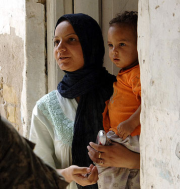IRAQ: Squatters moved out of nearly two thirds of returnees’ homes
Nearly two thirds of homes belonging to Iraqi internally displaced persons (IDPs) or refugees that were occupied by squatters have been evacuated since mid-2008, a government official said on 9 January
BAGHDAD, 10 January 2010 (IRIN) - Nearly two thirds of homes belonging to Iraqi internally displaced persons (IDPs) or refugees that were occupied by squatters have been evacuated since mid-2008, a government official said on 9 January.
Sadiq Amer, who runs one of the two main offices of Iraq’s Ministry of Displacement and Migration in Baghdad, said squatters had taken over 3,099 homes of IDPs and refugees as of July 2008, after which the government ordered their evacuation to encourage returns.
“As of 20 November 2009, 1,164 houses had been evacuated in Baghdad’s Karkh area [western side of the city] out of 2,299 houses that were occupied. While in Rasafa [eastern side] about 800 [homes] have been evacuated,” Amer told IRIN.
Amer said 18,123 IDP and refugee families had returned to Karkh and 14,000 families to Rasafa as of 5 January.
Since July 2008, the government has made a concerted effort to encourage the return of IDPs and refugees to the areas of origin. One element of this initiative was to crackdown on squatters by offering them a one-off payment of 1.8 million Iraqi dinars (US$1,525) to assist them in finding legitimate accommodation to rent.
In early 2008, the displacement ministry released its first report on the number of illegally occupied houses - 3,491 in nine provinces: Baghdad, Diyala, Anbar, Salaheddin, Ta'mim, Babil, Kut, Nineveh and Muthana. These included houses, flats, land and other buildings.
Abdul-Khaliq Zankana, head of parliament's committee on displacement and migration, said the evacuation decree “has not been implemented properly, as only a limited number of people have returned to their houses so far and the majority is still waiting as their houses are still occupied by other families”.
He said the worst squatter neighbourhoods of Baghdad were al-Jamia in western Baghdad, al-Hurriyah in the north, al-Dora in the south and Saidiya in the southwest of the capital.
"I swear that I have not heard until now that even one family has been paid the one-off payment,” Zankana told IRIN.
He blamed long-winded procedures and bureaucracy.
Amer said that only one squatter family had taken the one-off payment, as the decree covered only those squatters who could not go back to their areas of origin, which he said were very few.
He acknowledged that the process of evacuating a squatter took considerable time as each request by home owners had to be sent to Baghdad's security and real estate authorities to check the ownership of the house.

